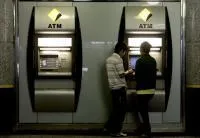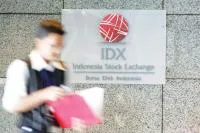Feature
Kris Hendrieckx talks with Asian Banking & Finance on next two Sibos events in Asia
Kris Hendrieckx talks with Asian Banking & Finance on next two Sibos events in Asia
Sibos will be back in Singapore in 2015 and Asian Banking & Finance interviewed Sibos Head Kris Hendrieckx to talk about what Asian bankers can expect from the next two Sibos events in Asia.
Bringing Asia’s Financial Services Industry to the Cloud
IT has suffered from an image problem across much of the financial services world.
ATM suppliers in Asia note brisk sales despite global crisis
Consumers want more from their ATMs aside from cash.
Card payments in Asia Pacific: the state of the nations
Andrew Dickinson takes a look at some big changes ahead in the credit card arena, particularly in Australia.
Investing with your all-weather financial partner
You might see your wealth protection and growth plans get displaced in the current economic climate, but having the right banking partner makes all the difference.
A guiding partner for SME development
Everyone acknowledges the SMEs important role in economic growth, social cohesion, employment and local development, accounting for over 95 percent of enterprises and 60 to 70percent of employment. However, few can suitably assist SMEs in many of traditional problems it faces such as lack of financing. Leading the way is the United Overseas Bank (UOB) which has been supporting SMEs before everyone else took notice. And since the 1930s, they have skillfully guided many of their partner SMEs during their early start-up to help them grow into major corporations with an international presence.
Effecting a ‘prison’ escape from binding loan terms
Quirky. . . clever. . . captivating. These three words best describes GE Money Singapore’s advertising campaign for JAMES that features a humorous juxtaposition of life’s joy and pain situations.
Uplifting women through financial empowerment
Women are increasingly balancing their acts of earning for the family while tending to their role as home makers. United Nation’s data revealed that one-third of all families are headed now by a woman as the sole-provider. Unfortunately the same report also shows that more than 700 million women world-wide live on less than one dollar a day.
Will sport sponsorship be running on empty in 2009?
“Nobody knows what’s going to happen,” said F1 guru, Bernie Ecclestone, when asked what the impact of the financial crisis will be on major sports sponsorship.
Liberating trapped liquidity through a centralised treasury
ABN AMRO’s Timothy O’ Keeffe explains the challenges faced by corporate treasuries and recommends ways on how to achieve a more centralized and automated flow of information and investments.
Indonesia’s foreign bank spending spree
Big-name foreign bank CEO’s can be forgiven for thinking Indonesian lenders are the best things since sliced bread. Maybank and HSBC in the space of a month, have both made big plays for Indonesian banks, PT Bank Internasional Indonesia and PT Bank Ekonomi Raharja. Just in September, Maybank shelled out over USD one billion for a 55 percent stake in Internasional. And in October HSBC purchased an 88.9 per cent stake in Ekonomi for USD 608 million.
Why ‘Gapping’ may not be enough to bridge the gap
As the big names in global banking continue to tumble, more than a few eyes have been turning to the local markets to ask the inevitable (but unthinkable) what if it happens here? Hong Kong already experienced its own taste of possible disaster when a string of malicious SMSs sent Bank of East Asia depositors into a tailspin. In Singapore, life insurance company AIA saw round-the-block queues when its parent AIG received US government intervention, and policy holders panicked that their life savings were about to vanish. So far, the club of three banks – DBS, OCBC and UOB – seem to be holding their head above water. And analysts predict that, provided their loans’ business obeys the rules from the Asian Financial Crisis - where the local consumer loans held up and bad debts came largely from regional corporate exposure – the three should be OK.
Has NAB nabbed top spot for good in Austraila?
Like a thief in the night came National Australia Bank to snare the top spot on the rungs of Australia’s banking ladder. And with growing fears of a recession plaguing banks down under, a USD2 billion cash injection could come as a shock. But the question is why does NAB have an extra AUD3 billion floating around in its coffers? The bank undertook a significant capital raising through the sale of its shares to institutional and retail investors, according to UBS analyst Jonathan Mott. Back in November, NAB announced both the institutional placement and retail share purchase plan. Mott said the bank raised capital in order “to strengthen its balance sheet and to finance organic growth.” But is it too little, too late for NAB, with local banks like Macquarie and ANZ already being slammed by the credit crunch? It seems the NAB’s timely capital raising efforts have given the bank the highest capital ratio of all the lenders down under, meaning it is well on its way to becoming the top dog in Australian banking. Mott estimates a “Tier 1 ratio of 8.13 percent for the 2009 financial year, which should place NAB towards the top end of peers. It is now ahead of its peers in terms of capital flexibility.” And with NAB scoring the first-mover’s advantage over its competition, it’s no surprise that the bank’s deputy CEO, Michael Ullmer is all smiles. “The group completed the placement before any other banks embarked on capital management initiatives,” he said.
Loans fast becoming a risky business
Korea’s banking sector may have nothing to do with Tom Cruise, star of the film Risky Business or his penchant for the occult for that matter, but one thing is certain, loans are becoming a risky business for Woori Financial Group. So far this year, Woori has been plagued with a spate of non-performing loans or NPL’s and the nasty little critters just don’t seem to be going away. A worrying trend seems to be developing at the bank with a dramatic increase in new NPL formation to USD616 million in the third quarter of 2008. So why should Woori worry? Should new NPL formation exceed USD771 million in the subsequent financial quarters of 2009 and provision rates escalate above 60 percent, provisions in the realm of USD463 million per quarter could be a realistic scenario in the next 18 months or so, according to UBS analyst, SoYoung Kim. Kim expects there to be a “higher level of provisions at USD494 million in the fourth quarter of 2008 as this period will see more SME bankruptcies, particularly as borrowers face year-end audits and scrutiny.” The Korean lender just happens to have the largest SME loan portfolio of all Korean banks at USD72 billion. So how will the increase in new NPL’s and provisions affect Woori’s bottom line? The bank is expected to hit losses in the fourth quarter of 2008 and this coupled with the possibility that 2009 provisions may be front-loaded to the first quarter of 2009 could result in “Woori’s Tier 1 ratio dropping from 7.6 percent down to 6.4 percent,” said Kim. So what can Woori do to perk up its Tier 1 ratio? The bank needs over USD1.5 billion in new Tier 1 capital in order to lift its ratio above 7.5 percent. “Woori may need to issue Tier 1 equity in 2009 in a range of USD1.5 trillion,” which represents 34 to 42 percent of its current market cap,” said Kim. While it seems like Woori and other banks are never too far from the bad news, the Korean lender should be able to breathe a sigh of relief now with earnings expected to jump from USD77 to USD193 milllion in the second quarter of 2009 and NPL’s remaining “relatively low at 0.8 percent of USD2 billion in loans,” said Kim.
Does Bank Century mark a return to ‘97 for Indonesia?
Market reaction to the first significant bank failure in South East Asia couldn’t have been more subdued if the entire proceedings had happened deep in darkest Myanmar. That Bank Century’s ignominious fall from grace occurred in the region’s biggest, and one of its most vigorous, democracies could herald an era of market apathy. Rather like disaster fatigue, where victims no longer respond to the horror around them, global financiers have been on the receiving end of so much bad news in the past eighteen months, it’s hardly surprising that the reports of Bank Century’s suspension from the Indonesia stock exchange was written off as largely irrelevant.UBS analysts responded with comments that the bank’s suspension would cause ‘limited damage to the industry given Century’s small size’ and Reuters gave the news no more than a cursory paragraph. Why then the kerfuffle? Surely swift regulatory intervention is what is required when financial institutions look likely to go belly up, so we are told. Whatever Dick Fuld’s sins, no one could have believed that Lehman’s true value could have fallen so far that it warranted filing chapter 11 – and Lehmans serves as a warning of what can happen when panicked markets are left to act alone. A swift fix for Century, no media hyperbole and carry on smiling – good news all round. Perhaps. Before we go into the questions that Bank Century’s takeover raises, if you missed the ½ column inch devoted to Indonesia’s 13th largest bank, here’s a quick update. Bank Century was formed in 2004 from the merger of PT Bank CIC, PT Bank Pikko and PT Bank Danpac: one of the series of government instigated mergers following massive bank failures and loan defaults in the 1997 financial crisis. Last in trouble in 2007, when it was reported to have capital raising issues, it remained profitable in the first three quarters of 2008, albeit showing lower returns than prior year. On 13th November Bank Century failed to participate in regulatory daily clearing with the Bank of Indonesia. An administrative error, claimed management including co-founder Robert Tantular who, along with other bank executives, has since received a ban on leaving the country for six months. Bank of Indonesia wasn’t satisfied with the explanation and suspended Century’s shares. Subsequently it was determined that its capital adequacy ratio had fallen to 2.3 percent, below the minimum 8 percent required by the central bank. What follows then, remains unclear. According to certain reports, Century’s corporate secretary Deddy Triyana claimed the bank made the clearing settlement later on the same day it was due and a technical gliche had been to blame. Other reports state that the suspension was as a result of speculation over liquidity since Century had failed to meet an interbank obligation. Probably the most comprehensive explanation was that Century may have hit a funding crisis brought about by holdings of foreign debt securities. According to central bank officials, Century had failed to receive funds from around US$56 million worth of bonds maturing in late October and early November, causing its liquidity problems. Siti Fadjrijah, a deputy central bank governor, said, “The trouble at Bank Century was mostly related to its holdings of debt securities denominated in foreign currency.” Neither Fadjrijah nor her colleagues named the issuers of the debt, nor did they explain where the eventual funding was raised (if indeed it was) to meet the late obligation. In the end it didn’t matter. Century was forced to close negotiations with Sinar Mars (a local conglomerate that had been negotiating to take up to 70% of Century) and allow the Indonesian Deposit Insurance Agency to take control of the bank. Emergency funding was promised to, ‘gradually increase the capital adequacy ratio to at least 8 percent,’ said Firdaus Djaelani, chairman of the agency, after which he will, ‘look for new investors.’ In the meantime, Mr Tantular has been shoved aside to make way for Maryono of Bank Mandiri, Indonesia’s largest lender by assets, as interim president of Century. According to Mr Maryono, Bank Mandiri has no interest in buying shares in the ailing bank, waylaying any fears that this is the forced imposition of a favoured baron.If the facts (as far as can be ascertained) are correct, Indonesia’s regulators have intervened swiftly to prevent a possible deposit run on a small yet significant domestic bank. Mopping up widespread market panic would ultimately be far more costly-450 trillion rupiah were spent after the 1997 crisis. But what of the unanswered questions that have been so neatly swept aside in this Commando-style operation. Who are the issuers of the debt securities that caused Century to fail liquidity measures? What has happened to these securities now? And, more frighteningly, how widespread are such securities in the Indonesian banking sector? Mr Djaelani and Ms Fadjrijah might be patting themselves on the back for a rapid strike and mopping up exercise, but until the full facts emerge the fear of more danger lurking on Indonesia’s banking balance sheets remains a potent one.













 Advertise
Advertise














Commentary
Thailand backs major conglomerates for digital banks but risks stifling innovation